Jul 2013
Decorative Lighting Guidelines for any Room – Pendants
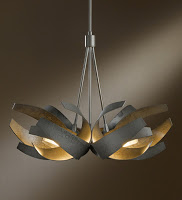
Decorative lighting includes Wall Sconces, Chandeliers, Flush Mounts, Semi-Flush Mounts and Pendants. The proper combinations of these five elements insure an interesting, attractive lighting design for any room. Using different elements of lighting is called layering. Many layers of light make the difference between an OK room and WOW room.
 |
| How’s This For a Cool Pendant! |
Pendants are perhaps the most versatile of all decorative lighting fixtures.They can be as dramatic as a chandelier, as understated as a wall sconce or as functional as a floor lamp. They can be used to provide ambient, task or accent illumination. They can be used alone on in groupings. They are available as line voltage, low voltage halogen and LED. They can be made of glass or metal or a combination. They can be modern, traditional or transitional. Whatever your taste and lighting need there is a pendant for you.
Pendants are traditionally used in kitchens as task or accent lighting over islands, sinks or kitchen tables. But pendants are also used in foyers, in hallways with high ceilings, in dinning rooms over tables and in bathrooms. They are used as exterior fixtures on porches and entries. As long as you have adequate ceiling height, you can use pendants almost anywhere.
When choosing a pendant be sure that the light output meets your lighting needs. I have customers who would love to have small, colorful pendants over task ares in their kitchens. Unfortunately most of these do not provide enough task light for the application. So unless you can supplement the light with recessed lighting, such fixtures do not provide sufficient lighting for kitchen tasks. Be a savvy shopper and always match your lighting needs to the fixture you are buying.
Please visit http://www.fogglighting.com and like us on Facebook. I am always available for consultations on lighting plans.
Jul 2013
Decorative Lighting Guidelines for any Room – Flush Mounts
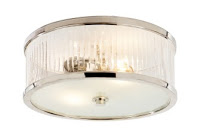
Decorative lighting includes Wall Sconces, Chandeliers, Flush Mounts, Semi-Flush Mounts and Pendants. The proper combinations of these five elements insure an interesting, attractive lighting design for any room. Using different elements of lighting is called layering. Many layers of light make the difference between an OK room and WOW room.
 |
| Hip Flush-Mount |
Flush mounted light fixtures are the most maligned light fixtures of all fixtures. They have earned their reputation because of all the bad flush-mounts out there in the lighting universe. Guess what – there are some really attractive flush-mounts available and they are absolutely needed in lots of applications. In certain applications, when you do not want to make a decorating statement, there are really plain vanilla flush-mounts that just sort of disappear on a white ceiling. Flush-mount do not have to be ugly! Dispense with any preconceived notions about flush mounted fixtures and welcome them into your home. You do not have to be ashamed to say you have a flush-mount in your front hall!
Because they illuminate with little downward obtrusion, flush mounted fixtures are ideal for providing ambient light in high traffic areas, such as hallways. They can also work well as a centerpiece when a lower hanging fixture would interfere with views or flow, especially when ceiling height is limited. I like using a flush mounted center ceiling fixture in bedrooms, usually a plain white one. Closets and laundry rooms are other areas where a flush-mounts are ideal. Outside porches, bathrooms and even showers are opportunities for using flush mounted fixtures, provided they have either damp or wet location ratings. Let your imagination be your guide.
Please visit http://www.fogglighting.com and like us on Facebook. I am always available for consultations on lighting plans.
Jul 2013
Decorative Lighting Guidelines for any Room – Chandeliers
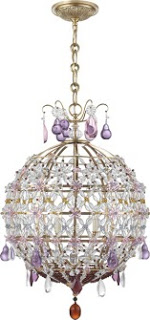
Decorative lighting includes Wall Sconces, Chandeliers, Flush Mounts, Semi-Flush Mounts and Pendants. The proper combinations of these five elements insure an interesting, attractive lighting design for any room. Using different elements of lighting is called layering. Many layers of light make the difference between an OK room and WOW room.
 |
| Beautiful New Design |
Chandeliers, the crown-jewel of a room’s lighting array, is a showpiece of decorative sentiment and material beauty. Chandeliers are available in a multitude of different styles and designs, from the sublime to the ridiculous and everything in between. Your choice of a chandelier is a very personal matter. Some folks like a lot of metal, some like crystal, some like modern and some like traditional. There is no wrong choice. It is purely a matter of personal taste. Since the chandelier is usually the focal point in a room it sets the design fulcrum of the room.
Proper sizing is essential in choosing your lighting centerpiece. Too small and your chandelier will be lost among the other elements in the room. Too large and it will obtrude. There are a few guidelines for picking the correct size chandelier. Add the dimensions of the room in feet and then use that result in inches to determine the diameter. For example: a room is 10′ x 12′, add 10 + 12 = 22′ converted to inches = 22″, a 22″ diameter chandelier would be appropriate. The larger the room the more variance is allowed. A chandelier over a dining table should be no larger than 3/4 the table’s width and extend no closer than 6″ to the table’s edge. (A chandelier over a table should be at least 30″ above the surface of the table. The higher the ceiling, the higher above the table it can hang up to 36″). The height of a chandelier is determined by the ceiling height. Obviously a really high ceiling can accommodate a taller chandelier than a really low ceiling.
Please visit http://www.fogglighting.com and like us on Facebook. I am always available for consultations on lighting plans.
Jul 2013
Decorative Lighting Guidelines for any Room – Wall Sconces
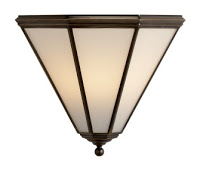
Decorative lighting includes Wall Sconces, Chandeliers, Flush Mounts, Semi-Flush Mounts and Pendants. The proper combinations of these five elements insure an interesting, attractive lighting design for any room. Using different elements of lighting is called layering. Many layers of light make the difference between an OK room and WOW room.
 |
| Decorative Wall Sconce |
Wall Sconces placed midway on the wall can be used to balance overhead lighting and add a thoughtful dimension to your decor. The eye-level spread of light along a wall helps create an intimate ambiance in rooms and halls. As accent pieces, sconces can be used to flank architectural features, such as fireplaces and archways. In bedrooms sconces can be mounted on each side of the bed to serve as reading lights. While it is not necessary to match sconces to the style of overhead fixtures, keeping them within the same finish family will add continuity to the overall design. I actually like to combine modern and traditional styles in the same room to add a little pizzazz.
A sconce’s light source, not necessarily the back plate, should be mounted between 65″ – 68″ above the floor. Some sconces are linear and the back plate is either higher or lower than the actual light source. In these cases the electrical junction box must be located in the proper position on the wall to enable the light source to be at the proper height. Some scones have a narrow back plate and require a narrow junction box, called a switch box, rather than the junction boxes that most electricians routinely install. Please be sure to keep these facts in mind to avoid disappointment during the installation phase of your project.
Please visit http://www.fogglighting.com and like us on Facebook. I am always available for consultations on lighting plans.
Jun 2013
Factors to Consider in a Lighting Plan – Part 1
There are many factors to consider when designing lighting for an architectural space. One of the most important factors is ease of seeing. Ease of seeing varies greatly, but generally speaking older people need more light to see the same details than younger people can see with less light. Eyes over 40 years old are older eyes for this this discussion. People who wear eyeglasses are also susceptible to having issues as well. Age effects vision in a number of ways including depth perception, peripheral vision, glare, and visual acuity.
The photo at the left shows a room that has a lot of daylight as well as artificial light from many sources. It is a comfortable, inviting space with a relaxing color pallet. The lighting in this large room is one of the most important factors in how the room feels and how easy it is to navigate through the space. Furthermore there is adequate light for the tasks that are performed there. This room is comfortable for both young and old eyes. There is no glare, there is plenty of light and the walls are well defined. The lighting designer provided many layers of light without overpowering the space. A great balance.
Please be sure to visit FoggLighting.com and contact us with your questions and to help with your lighting needs. Our staff is trained in lighting design and can help with all your lighting questions.
Jun 2013
The Psychology of Lighting Design
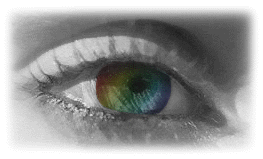
It is crucial for a lighting designer to know how humans react to different colors of light and to the contrast between light and dark. This knowledge combined with knowing what tasks are performed enable the designer to effectively illuminate an interior space.
The eye functions almost like a camera sending images to the brain. Cones in the eye provide color vision in bright environments and rods in the eye provide shades of gray in dark environments. Brightness defines luminance which is the intensity of light entering the eye. Light meters measure this as lumens. The variations in the brightness of objects is defined as contrast. Colors in the middle of the visible spectrum appear brighter than colors at outside edges of the spectrum.
People react differently to different colors and have likes and dislikes for colors. Light and color influence our mood and feeling and affect our biorhythm and circadian rhythm. Red light is psychologically stimulating and can even raise blood pressure and heart rates. Red objects appear closer that they actually are. Blue is the opposite of red. It has a calming effect and appears further away that it is. Green is the most restful color for human vision.
In addition to color the amount of contrast determines how one perceives an architectural space. Environments that are complex, asymmetrical, unfamiliar or unorganized cause a sensory overload. In such situations complex tasks are avoided because people are distracted, annoyed or frustrated. Therefore attention to color, contrast and the activities that occur will enable a lighting designer to match the lighting to the tasks and create an inviting space.
Be sure to visit FoggLighting.com and like us on FaceBook. We have trained personnel to help you with lighting design and fixture selection.
May 2013
Home Theater Lighting
In today’s upscale homes an home theater is becoming more and more common all the time. Why go out when you can have all the benefits of the big screen in the comfort of your home! Of course lighting a home theater must be executed correctly to fully enjoy the viewing experience.
| Front view of a beautiful home theater. |
In the photo to the left you will see an example of an amazing home theater. Notice all the layers of light. That is what differentiates an ordinary room from a spectacular room (not just a home theater room, but any room). The lighting in this room combines LED and halogen. (The room was build several years ago before reliable LED tape light products were available).
Another crucial element in home theater lighting is the lighting control package. You want to be able to dim the lights and control all the circuits from the comfort of you seat. This sophistication is expensive and requires an experienced lighting controls expert to execute, but it makes all the difference in the world.
| Rear view of the home theater. |
I am proud to say that the lighting in this room was provided by Fogg Lighting Please visit us at FoggLighting.com and call and email with any questions or requests. And remember when you build your next house include a home theater. It doesn’t need to be this elegant, but it will still be fun. Remember….layers of light!!
May 2013
A Maine Historical Society Exhibit
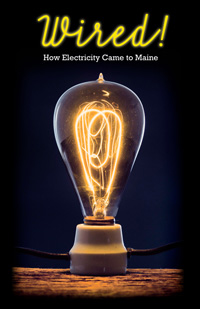
Wired: How Electricity Came to Maine
Exhibit Dates: June 22, 2012 – May 26, 2013

Wired! explores the electrification of Maine during the 20th century, and how a rural state became modern. Told primarily through material from the Central Maine Power collection, it explores the landscape, mechanics, economics, politics, and culture of electricity.
The story begins with efforts to harness the energy of Maine’s rivers to power small mills. It spreads as entrepreneurs, tinkerers, and investors sought to transmit that energy further and further, and to sell it to businesses and homeowners. Finally, the story is about the grid, and what it took to get it built.
The exhibit explores how Mainers were shaped by power: engineers and linemen who figured out how to deliver electricity to the masses, and people everywhere who overcame initial fears to embrace and rely on it for almost every aspect of their daily lives. As we continue to look for affordable, clean energy, this is a story that joins Maine’s past, present, and future.
Please take time to visit this fascinating exhibit at The Maine Historical Society, 489 Congress Street, Portland, ME. You can check their website, http://www.mainehistory.org/, for hours. And please visit www.FoggLighting.com for all your lighting needs.
May 2013
What Is Light and Why It Is Important
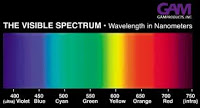
Vision provides us with most of the information that we rely on to survive, and vision would not be possible without light. Light is the stimulus for vision. The receptors in the eye only respond to electromagnetic energy between 380 nanometers (nm) and 760 nanometers (nm). The difference between x-rays, radio waves, UV, IR and visible light is their wavelength. When light travels through a prism the speed at which it travels slows down and the light waves are bent and refracted at different angles so the light emerges as a fan of different colors. What we see as colors are the colors in the light. A blue wall is blue because the light source contains wave lengths in the blue part of the spectrum.
Since light is such an important factor in all our lives it is essential that the environments that are created by lighting designers must allow the eyes to function at optimum levels for the psychological and general well being of the inhabitants. That is the reason you must take control of your lighting. Learn as much as you can about proper lighting so that you will be able to direct the installation of that lighting. But if you do not want to take the time to do that, hire a trained lighting professional to represent your interests. Get the lighting you want and need. The difference between good and bad lighting is huge and will impact your life for years. Budgets are tight, but do not skimp on the lighting…it is what enables you to enjoy everything else in your house.
Please visit FoggLighting.com and like us on Facebook.
Apr 2013
The American Lighting Association

I belong to the America Lighting Association as do many other lighting showrooms, lighting manufacturers and lighting representatives throughout North America. I think this association is really worthwhile. They run an annual conference and provide training for lighting designers and showroom employees throughout the year. And they maintain a web site loaded with information for consumers. If you want some ideas about how to light your home, I urge you to visit www.americanlightingassoc.com to take advantage of all the useful information presented there.
I became a Certified Lighting Consultant, the highest certification bestowed by the ALA, because I feel it is necessary to be as helpful as possible to my clients. (There are fewer than 1,000 CLC’s throughout North America and only two in Maine). Other degrees offered are: Lighting Associate, Lighting Specialist, Certificate Specialist and Certified Lighting Manufacturers Representative. Fogg Lighting has sent all our employees to training programs and I am proud to say we have several Lighting Specialists on our staff. When you see the American Lighting Association logo on a lighting showroom’s door you can be fairly certain that that showroom is a reputable organization.
Please visit FoggLighting.com and like us on Facebook.

